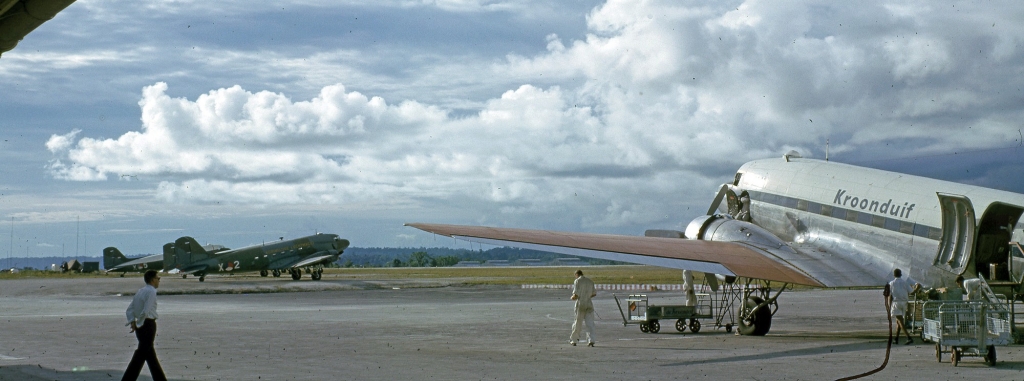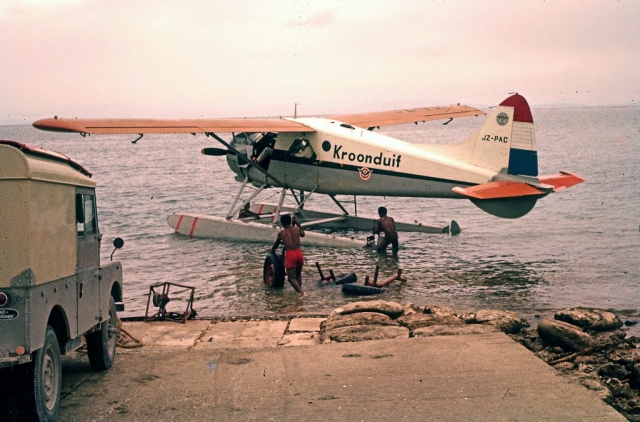 Images of the past: civil aviation in New Guinea (long read)
Images of the past: civil aviation in New Guinea (long read)
After the independence of Indonesia in 1949, New Guinea remained part of the Kingdom of the Netherlands. Garuda became the national carrier of the new country, taking over the routes formerly served by KNILM (Royal Dutch East Indies Airlines).
But the routes in and around New Guinea were excluded. So the Government of New Guinea decided to hire a Douglas Dakota from KLM. This aircraft, PH-TCB, arrived in August 1950. A second one, PH-TCY, arrived in the summer of 1952. The airport of Mokmer on the island Biak was chosen as the hub for operations into New Guinea.
Obviously the Dakota could only land on prepared strips of which there were very few. Alternative low level droppings of food and supplies were carried out, but these were not always successful. The Marine Luchtvaart Dienst (Royal Netherlands Navy) contributed, taking passengers and cargo on around 30% of their Catalina flights to the lakes in central New Guinea.
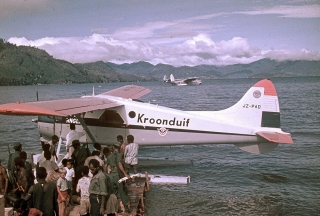
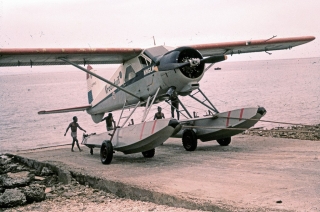 As this was an unwanted situation, the Government decided to buy two float-equipped DeHavilland Canada Beavers, which were registered as JZ-PAA (msn 633) and JZ-PAB (msn 636). In November 1954 a new airline, De Kroonduif or NNGLM (Nederlands Nieuw Guinea Luchtvaart Maatschappij) was founded by the Government and KLM. But the Government withdrew and De Kroonduif became a 100% KLM daughter company.
As this was an unwanted situation, the Government decided to buy two float-equipped DeHavilland Canada Beavers, which were registered as JZ-PAA (msn 633) and JZ-PAB (msn 636). In November 1954 a new airline, De Kroonduif or NNGLM (Nederlands Nieuw Guinea Luchtvaart Maatschappij) was founded by the Government and KLM. But the Government withdrew and De Kroonduif became a 100% KLM daughter company.
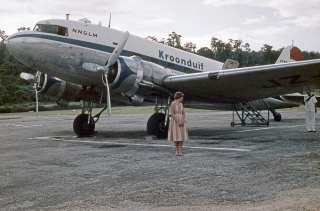
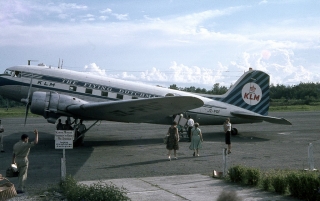 The KLM Dakotas were passed on to the new company as were the two Beavers which were delivered in July 1955. In January 1956 PH-TCB became JZ-PDB and PH-TCY became JZ-PDC. A third Dakota, JZ-PDA, was flown by De Kroonduif until mid 1957 and then passed on to KLM Aerocarto. PDB and PDC were exchanged by two other Dakotas, JZ-PDD and JZ-PDE in 1957. Four years later a third passenger Dak joint these two: JZ-PDF.
The KLM Dakotas were passed on to the new company as were the two Beavers which were delivered in July 1955. In January 1956 PH-TCB became JZ-PDB and PH-TCY became JZ-PDC. A third Dakota, JZ-PDA, was flown by De Kroonduif until mid 1957 and then passed on to KLM Aerocarto. PDB and PDC were exchanged by two other Dakotas, JZ-PDD and JZ-PDE in 1957. Four years later a third passenger Dak joint these two: JZ-PDF.
A remarkable photo as this Douglas C-47A although registered to De Kroonduif as JZ-PDF still carries the full colours of its former owner KLM. Its Dutch registration PH-DAT was cancelled on 23 November 1961. This photo must have been taken shortly afterwards.
To serve even the smaller airstrips in central New Guinea, three Scottish Aviation Twin Pioneers were ordered, JZ-PPX (msn 509), JZ-PPY (msn 510) and JZ-PPZ (msn 511). Unfortunately ‘PPX’ was lost within two months after delivery when it crashed near Japen Island during a training flight. It was replaced by another Twin Pioneer in 1961, JZ-PPW (msn 579). The three STOL Twin Pioneers were passed on to Garuda Airways in 1963.
The Beaver soon became a popular bushplane in New Guinea, and two more examples were registered in 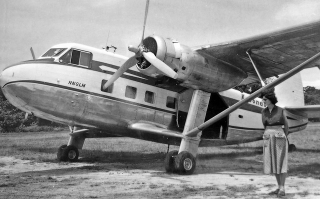 September 1956: JZ-PAC (msn 947) and JZ-PAD (msn 951). Flying into the interior was sometimes a hazardous job and not only because of the weather conditions. On several occasions Beavers had their floats punctured by underwater obstacles.
September 1956: JZ-PAC (msn 947) and JZ-PAD (msn 951). Flying into the interior was sometimes a hazardous job and not only because of the weather conditions. On several occasions Beavers had their floats punctured by underwater obstacles.
Beaver JZ-PAB was written off on 16 November 1957 when it crashed on a beach near Merauke. Three of the four crewmembers were killed in this accident. A fifth Beaver JZ-PAE (msn 645) was added to the fleet in May 1961. After the withdrawal of the Dutch, the quartet of Beavers was registered to Merpati Nusantara Airlines.
In the years after the Indonesian independence the connection with the Dutch motherland was obviously very important. In those days, KLM performed regular services from Amsterdam to Biak-Mokmer. Initially with the Lockheed (Super) Constellation, later with the Douglas DC-7Cs and from 1960 with the Douglas DC-8-30 jet. To accommodate these larger aircraft types the Mokmer runway was lengthened to 3,570 metres.
 Unfortunately KLM lost one of its L-1049E Super Constellations on 16 July 1957. Early in the morning of that day, PH-LKT 'Neutron' took off from Biak-Mokmer but then turned back for a supposed low run over the airfield. During this turn the Super Constellation hit the surface of the sea and crashed, taking the lives of 49 passengers and nine crew.
Unfortunately KLM lost one of its L-1049E Super Constellations on 16 July 1957. Early in the morning of that day, PH-LKT 'Neutron' took off from Biak-Mokmer but then turned back for a supposed low run over the airfield. During this turn the Super Constellation hit the surface of the sea and crashed, taking the lives of 49 passengers and nine crew.
But there was more aerial activity over New Guinea than that of airlines De Kroonduif. The impenetrable bush held promises of riches in oil and rare minerals so the companies interested sent in their exploration teams. Most notorious was the NV Nederlands Nieuw Guinea Petroleum Maatschappij (NNGPM) / Shell Oil, Den Haag, Netherlands.
As far as we know, three Consolidated PBY-5A Catalinas were registered to the NNGPM: JZ-POA (msn 1745), JZ-POC, and JZ-POD (msn 1809). The NNGPM also used two Grumman G-73 Mallards, JZ-POB (msn J13) en JZ-POC (msn J37). Mallard JZ-POB was flown in New Guinea until 1960. This Mallard is still active in 2021 as N2950! JZ-POC was withdrawn from use in 1958.

 Another company that used the Catalina was the Freeport mining corporation. They operated Canso A N68740 (msn 407) in New Guinea until 1970. Even helicopters were used, despite their limited payload, like those owned by Dutch firm Schreiner Aerocontractors. The company flew two float equipped AgustaBell AB47G helicopters during an expedition into Sterrengebergte in 1959.
Another company that used the Catalina was the Freeport mining corporation. They operated Canso A N68740 (msn 407) in New Guinea until 1970. Even helicopters were used, despite their limited payload, like those owned by Dutch firm Schreiner Aerocontractors. The company flew two float equipped AgustaBell AB47G helicopters during an expedition into Sterrengebergte in 1959.
Around July 1961, the Government realised that it was not in the interest of New Guinea that De Kroonduif still had the monopoly on aerial transport in the area and decided to break it up.
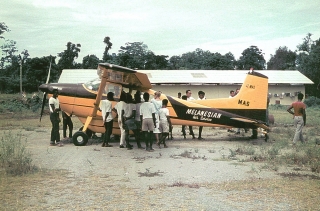
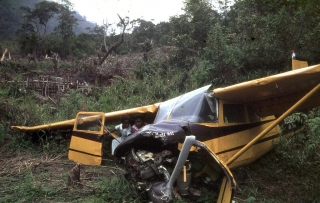 And so a group of private investors jumped in and founded Melanesian Air Service (MAS) in August of that same year. Unlike De Kroonduif, MAS had its homebase on the mainland of New Guinea, on the airfield of Hollandia-Sentani.
And so a group of private investors jumped in and founded Melanesian Air Service (MAS) in August of that same year. Unlike De Kroonduif, MAS had its homebase on the mainland of New Guinea, on the airfield of Hollandia-Sentani.
On 12 January 1962, the first aircraft arrived, Cessna 185 JZ-MAS which was baptised Anak Mas (Golden Child). It was fitted with a detachable cargobin underneath the fuselage, which could contain an additional 135 kgs of freight. Two months later a second Cessna 185 arrived, JZ-MAR which was baptised Burung Mas (Golden Bird).
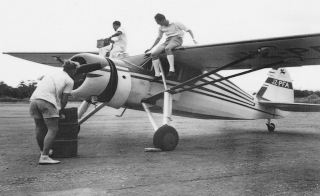 But the MAS fleet expansion was only short-lived, when JZ-MAS crashed into a tree near the Moelia strip in the inlands on 23 June 1962. Fortunately there were only minor casualties. As it was obvious that the Dutch, as a result of the changing political situation, would have to leave New Guinea soon, MAS ended its operations in September of that year.
But the MAS fleet expansion was only short-lived, when JZ-MAS crashed into a tree near the Moelia strip in the inlands on 23 June 1962. Fortunately there were only minor casualties. As it was obvious that the Dutch, as a result of the changing political situation, would have to leave New Guinea soon, MAS ended its operations in September of that year.
Apart from the commercially flown aircraft, there was only one privately owned machine, Fairchild UC-61 Argus JZ-PFA (msn 302). The owner, Mr. de Rijke, had acquired the aircraft, formerly PH-NGZ (and ex RAF EV792, ex USAAF 41-38856), in 1960. He regularly flew his Argus until he left New Guinea in 1962.
The photo below shows a typical scenery on Biak-Mokmer: a Kroonduif C-47A is prepared for its next flight, while three Koninklijke Luchtmacht (KLu, Royal Netherlands Air Force) C-47s are resting on the tarmac. The one nearest to the camera is serial X-2, while the one with the white fuselage top in the background is serial X-5.
Sources: www.papuaerfgoed.org and www.landewers.net


